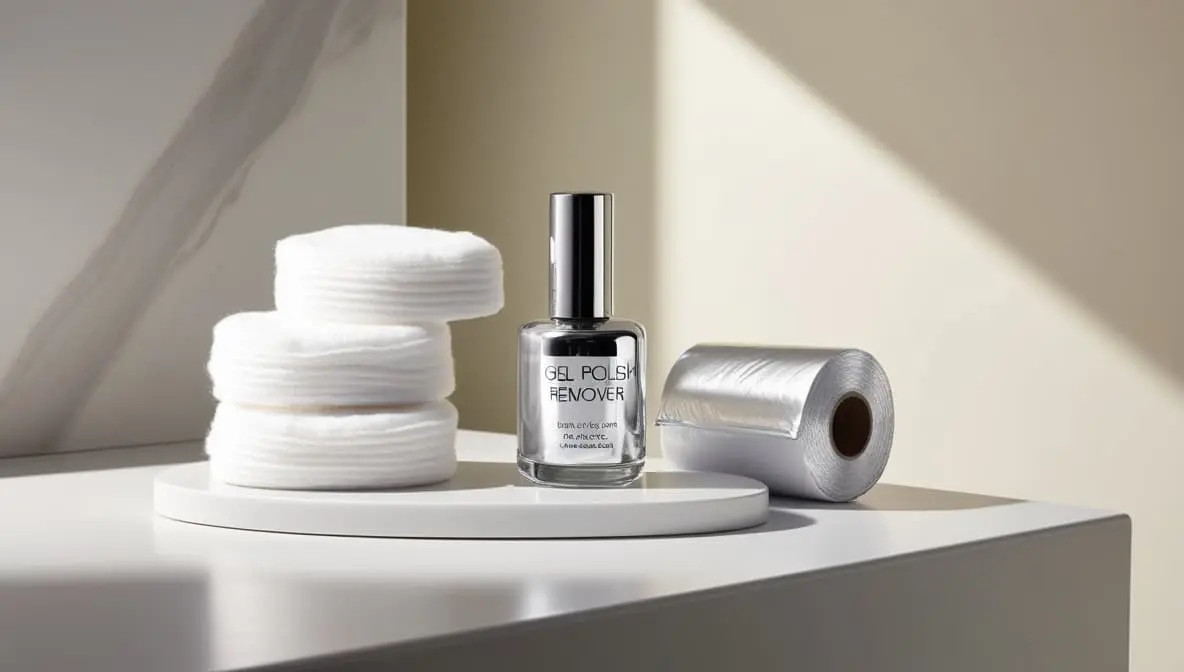Most people think that using a gel polish remover is a simple, straightforward process. You just soak your nails, scrape off the gel, and you’re done, right? Well, not quite. The truth is, if you’re not careful, you can end up damaging your nails, making them weak and brittle. So, let’s clear up the confusion and get into what matters when it comes to gel polish removers.
Why Proper Gel Polish Removal Matters
First things first, your nails deserve some TLC, especially when removing gel polish. Many people overlook the fact that improper removal techniques can do more harm than good. If you’ve ever wondered why your nails feel rough or look dull after taking off gel polish, it’s likely because the remover or method you used wasn’t right for your nails.
Using the wrong gel polish remover or scraping too hard can cause the top layers of your nails to peel, leading to weakened nails that are prone to breakage. That’s why it’s crucial to use the right products and techniques. The right gel nail color remover or acetone gel nail polish remover can make all the difference in maintaining healthy nails.

Choosing the Right Gel Polish Remover
Now that we know why proper removal is so important, let’s talk about how to choose the right gel remover for nails.
Understanding Different Types of Gel Polish Removers
Not all gel polish removers are created equal. There are two main types you’ll come across: acetone-based and non-acetone-based removers.
Acetone gel nail polish remover is the most common and effective for breaking down the gel polish. However, acetone can be harsh on your nails and skin if used frequently. It’s known to dry out the nails and surrounding skin, which can lead to brittleness. If you opt for an acetone-based remover, look for one that includes conditioning agents to help mitigate the drying effects.
On the other hand, non-acetone gel polish removers are gentler and better suited for those with sensitive skin or nails. However, they may require more time and effort to remove the gel polish effectively. These are great if you’re looking to avoid the harshness of acetone but still need a reliable gel remover for nails.
The Best Gel Polish Remover for Your Needs
So, which one should you choose? It depends on your nail type and what you’re looking for in a remover.
- For Sensitive Skin: If you have sensitive skin or nails that tend to dry out easily, go for a non-acetone gel polish remover. It’s gentler and less likely to irritate.
- For Quick Removal: If you’re short on time and need something that works fast, an acetone gel nail polish remover is your best bet. Just remember to moisturize your nails and skin afterward.
- For Eco-Conscious Choices: If you’re looking for something kinder to the environment, consider an eco-friendly gel polish remover. These products are usually free from harsh chemicals and are better for both you and the planet.
Remember, the goal is to find a remover that gets the job done without causing damage. It’s worth investing in a quality gel nail color remover that suits your needs, rather than just grabbing the first thing you see on the shelf. By choosing wisely, you can keep your nails looking great, even after the gel polish is gone.
The Real Deal About Removing Gel Polish at Home
A lot of people think that removing gel polish at home is a messy, complicated process that should be left to the pros. But here’s the truth: with the right steps and tools, you can easily and safely remove gel polish yourself without causing any damage to your nails. So, let’s break down how to do it right.
Step-by-Step Guide: How to Remove Gel Polish at Home
Removing gel polish at home doesn’t have to be a chore. In fact, with the right approach, it can be pretty straightforward. Here’s how you can do it step by step.
Preparing Your Nails
Before you even think about reaching for the gel remover for nails, you need to prep your nails. This step is often overlooked, but it’s crucial for making the removal process smoother and protecting your nails from unnecessary damage.
- File the Top Layer: Start by gently filing the top layer of the gel polish. This breaks the seal and helps the remover penetrate the polish more effectively. Don’t go too deep; just scuff the surface enough to dull the shine. This step is especially important if you’re using an acetone gel nail polish remover because it speeds up the process.
- Protect Your Skin: Before soaking your nails, apply a layer of petroleum jelly around your nail beds. This protects the skin from drying out, especially if you’re using an acetone-based remover. If you’re using a gel nail color remover that’s non-acetone, this step is still good practice, but less critical.
Soaking Off the Gel Polish
Now that your nails are prepped, it’s time to get down to business. The soaking process is where the magic happens, and doing it right can make all the difference.
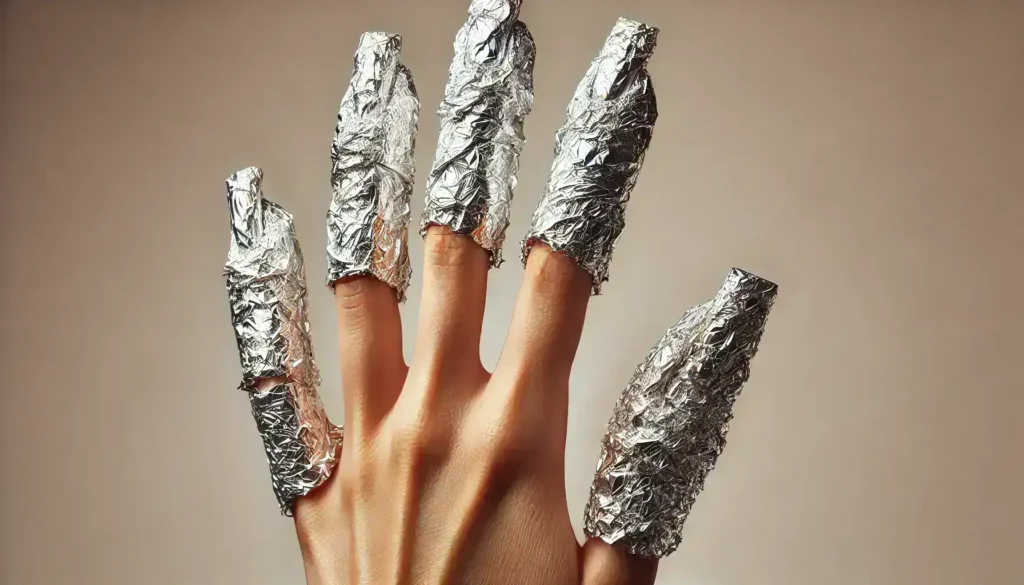
- The Foil Method: One of the most effective ways to remove gel polish is by using the foil method. Here’s how:
- Soak a cotton ball in your chosen gel remover for nails (whether it’s acetone-based or not).
- Place the soaked cotton ball directly on your nail.
- Wrap your nail with a small piece of aluminum foil to keep the cotton ball in place and trap heat, which helps the remover work faster.
- Let your nails soak for about 10-15 minutes. If you’re using a non-acetone gel polish remover, you might need to leave them wrapped a bit longer.
- Bowl Soak Method: If you’re not a fan of the foil method, or if you’re in a pinch, you can soak your nails directly in a bowl of acetone gel nail polish remover.
- Pour enough remover into a bowl to cover your nails completely.
- Soak your fingertips in the bowl for 10-15 minutes.
- This method works faster but can be more drying, so be sure to moisturize afterward.
Alternative Methods for Gel Polish Removal
Sometimes, you might not have acetone on hand, or maybe your nails are too sensitive to harsh chemicals. Don’t worry; there are alternatives.
- Soak-Off Gel Removers: There are specialized gel polish removers that are designed to be less harsh than pure acetone. These often come in the form of pre-soaked pads or a solution that’s gentler on your nails and skin. They might take a bit longer to work, but they’re a good option if you’re concerned about dryness or irritation.
- Natural Methods: If you want to avoid chemicals altogether, you can try soaking your nails in warm water mixed with a few drops of cuticle oil or olive oil. While this method won’t be as effective as an acetone-based nail gel remover, it can help loosen the polish enough to gently scrape it off with an orange stick.
Post-Soak Care: What to Do After Removing Gel Polish
Once your polish is off, it’s time to give your nails some love. Here’s what to do:
- Gently Buff Your Nails: After removing the polish, your nails might have some residue or rough spots. Use a gentle buffer to smooth the surface without thinning out your nails.
- Moisturize: Acetone and other removers can be drying, so be sure to moisturize your nails and cuticles right after. Use a nourishing oil or hand cream to restore moisture.
- Let Your Nails Breathe: If you’re a frequent gel polish user, consider giving your nails a break between applications. This helps them stay strong and healthy in the long run.
Debunking the Myth: Gel Polish Removal Isn’t Risky
A common belief is that removing gel polish is no big deal—you just soak it off and move on. But the truth is, if you’re not careful, you can end up causing serious damage to your nails. It’s not just about getting the polish off; it’s about doing it in a way that keeps your nails healthy and strong. So let’s dive into some tips and tricks to make sure you’re removing your gel polish the right way.
Tips and Tricks for Safe Gel Polish Removal
Removing gel polish doesn’t have to be a nail nightmare. With a few smart strategies, you can keep your nails in great shape while safely getting rid of that old polish.
Avoiding Common Mistakes
Let’s start by addressing the biggest mistakes people make when removing gel polish. Knowing what not to do is just as important as knowing the right steps.
- Don’t Peel Off the Polish: This is probably the most common mistake. It’s tempting just to peel off the gel polish when it starts to lift, but doing so can take off layers of your natural nail along with it. This leaves your nails thin and vulnerable to breakage. Instead, always use a proper gel remover for nails, like a gel nail color remover or an acetone gel nail polish remover. This ensures that the polish comes off without harming your nails.
- Don’t Rush the Process: Patience is key when removing gel polish. If you don’t allow enough time for the remover to do its job, you’ll end up scraping and pulling at your nails, which can lead to damage. Make sure you follow the soaking times recommended, whether you’re using the foil method or soaking in a bowl of acetone gel nail polish remover.
- Don’t Forget to Protect Your Skin: Acetone and other removers can be harsh on your skin. Always protect the skin around your nails with a barrier, like petroleum jelly, before soaking. This helps prevent dryness and irritation.
Post-Removal Nail Care
Once the polish is off, it’s not time to just walk away. Your nails need some extra care to bounce back after being wrapped up and soaked.
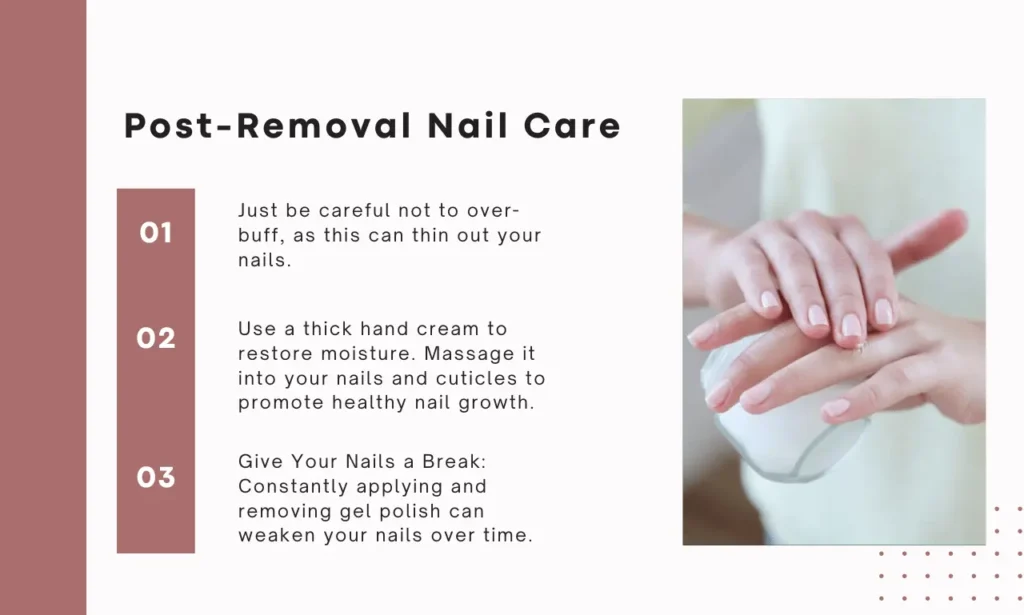
- Buffing: After removing the gel polish, your nails might have some leftover residue or rough spots. Gently buffing the surface can smooth things out and give your nails a healthy shine. Just be careful not to over-buff, as this can thin out your nails.
- Hydrating Your Nails: Acetone and other nail gel remover products can dry out your nails and the surrounding skin. After removing the polish, it’s crucial to rehydrate. Use a nourishing cuticle oil or a thick hand cream to restore moisture. Massage it into your nails and cuticles to promote healthy nail growth.
- Give Your Nails a Break: Constantly applying and removing gel polish can weaken your nails over time. It’s a good idea to give your nails a break between gel polish applications. Let them breathe for a week or two, and during that time, focus on keeping them hydrated and strong. This will help prevent brittleness and breakage.
Protecting Your Nails in the Long Run
If you’re a fan of gel polish, it’s important to think about long-term nail health. Regularly using gel polish doesn’t have to mean sacrificing strong, healthy nails.
- Use Strengthening Treatments: Consider using nail strengtheners between gel polish applications. These can help fortify your nails, making them less prone to damage. Look for products that contain ingredients like keratin or biotin.
- Mind Your Diet: Believe it or not, what you eat can affect your nails. A diet rich in vitamins and minerals, particularly biotin, zinc, and iron, can help keep your nails strong and healthy. If your nails are consistently weak or brittle, it might be worth looking into a biotin supplement.
- Choose High-Quality Gel Polish Removers: The remover you use plays a big role in how your nails fare after the polish is gone. Investing in a high-quality gel nail color remover or nail gel remover can make a difference in keeping your nails healthy.
By following these tips, you can enjoy the benefits of gel polish without the worry of damaging your nails. It’s all about being mindful and taking the time to care for your nails, both during the removal process and afterward.
A lot of people believe that all gel polish removers are pretty much the same—just grab one off the shelf, and it’ll do the job. But that’s not quite true. The type of remover you choose can make a big difference in how easily the polish comes off, how your nails feel afterward, and even how long the process takes. So, let’s dive into the different types of gel polish removers and how to choose the right one for you.
Choosing the Right Gel Polish Remover: What to Consider
Not all gel polish removers are created equal. Some are better suited for certain nail types, while others might offer a quicker or gentler removal process. Here’s what you need to know to pick the best option.
Types of Gel Polish Removers
The market is filled with various gel polish removers, and knowing the differences between them can help you make an informed choice.
Acetone-Based Removers:
These are the most common and powerful gel polish removers. An acetone gel nail polish remover works quickly to break down the polish, making it easy to remove. If you need fast results and don’t mind a bit of drying, this is usually your best bet. However, because acetone can be harsh, it’s crucial to follow up with proper nail and skin care, as discussed in the earlier sections.
Non-Acetone Removers:
These are gentler on your nails and skin but might take longer to remove the gel polish. If you have sensitive skin or weak nails, a gel nail color remover that’s non-acetone might be a better choice. Keep in mind that you’ll need a bit more patience with this type since the soaking time is usually longer.
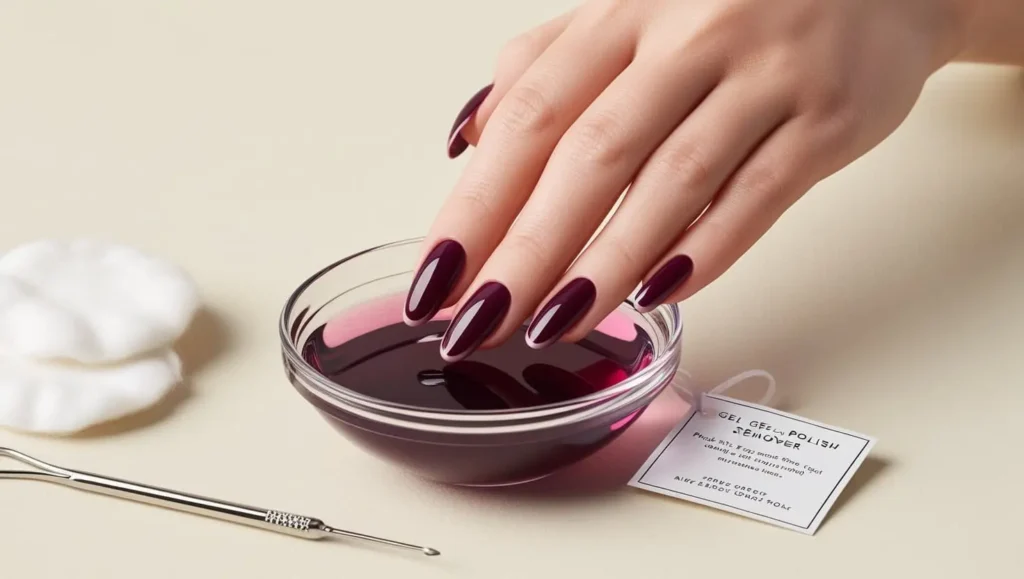
Soak-Off Gel Removers:
These are specially formulated for gel polishes and often come in the form of pre-soaked pads or liquid solutions. They strike a balance between effectiveness and gentleness. If you’re looking for something that’s easier on your nails and doesn’t require as much soaking time as non-acetone options, this might be the right gel remover for nails for you.
Factors to Consider When Choosing a Remover
When picking a gel polish remover, consider these factors to find the one that’s best for your needs:
Nail Condition:
If your nails are thin or brittle, opt for a non-acetone remover or a soak-off formula that’s gentler on your nails. This helps minimize damage and keeps your nails healthier in the long run.
Skin Sensitivity:
If your skin is prone to irritation, choose a remover that’s formulated with moisturizing agents or is specifically labeled as being gentle on the skin. This can help reduce the risk of dryness and irritation around your nails.
Time Available:
If you’re in a hurry, an acetone gel nail polish remover is likely your best option. It works faster than other types, making it ideal for quick touch-ups or when you need to remove your gel polish in a pinch.
Environmental Impact:
Some removers are more eco-friendly than others, using fewer harsh chemicals and offering biodegradable options.If sustainability matters to you, choose a nail gel remover labeled as environmentally friendly.
The Importance of Following the Right Removal Process
Even the best gel polish remover won’t do much good if you’re not following the proper removal process. Here’s a quick recap of what you should keep in mind:
Preparation is Key:
Always start by gently filing the top layer of your gel polish. This helps the remover penetrate more effectively, especially if you’re using a gentler formula.
Soaking Times Matter:
Be patient and follow the recommended soaking times for the remover you’re using. Rushing this step can damage your nails, especially if you’re tempted to scrape off the polish too soon.
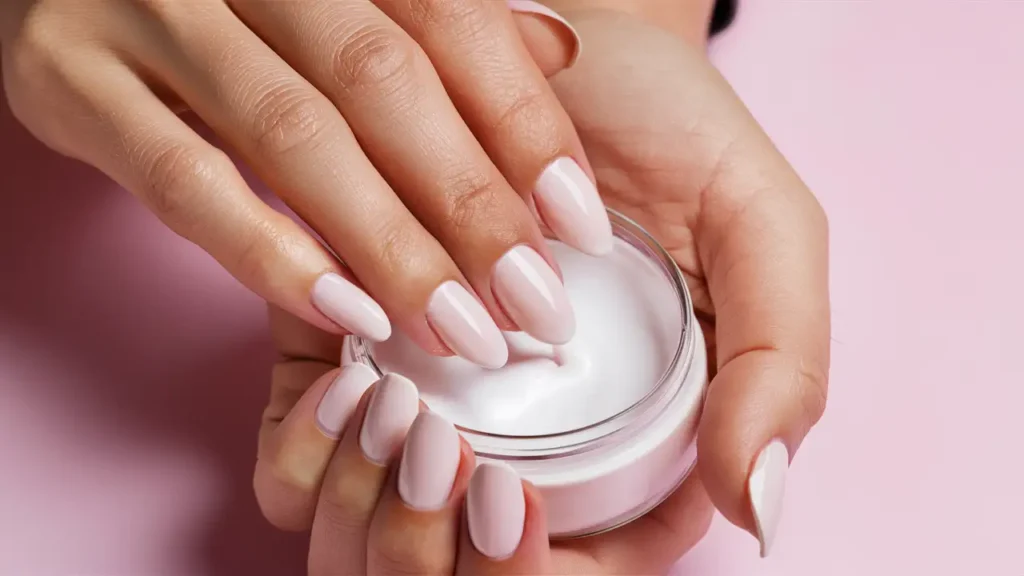
Moisturize, Moisturize, Moisturize:
No matter which type of remover you choose, always rehydrate your nails and skin afterward. This step is crucial to keeping your nails strong and healthy.
Final Thoughts on Choosing the Right Gel Polish Remover
Selecting the right gel polish remover is more than just a matter of preference—it’s about finding a product that suits your specific needs, whether it’s speed, gentleness, or something in between. By considering your nail condition, skin sensitivity, time constraints, and environmental concerns, you can choose a remover that works best for you and keeps your nails looking their best.
Frequently Asked Questions (FAQs)
Q: What does gel polish remover do?
A: Gel polish remover dissolves and removes gel nail polish from your nails.
Q: How often should I use gel polish remover?
A: Use gel polish remover as needed, but give your nails a break of at least a week between applications to keep them healthy.
Q: Can I use regular nail polish remover for gel polish?
A: No, regular nail polish remover isn’t strong enough. Use a dedicated gel polish remover for best results.
Q: What’s the difference between acetone and non-acetone gel removers?
A: Acetone removers work faster but can be drying, while non-acetone removers are gentler but take longer to remove polish.
Q: How can I protect my skin while using gel polish remover?
A: Apply petroleum jelly around your nail beds before soaking to shield your skin from the remover.
Q: How long should I soak my nails in gel polish remover?
A: Follow the product’s instructions, typically around 10-15 minutes, to ensure the gel polish softens properly.
Q: What should I do if gel polish isn’t coming off easily?
A: Extend soaking time, use the foil wrap method, or gently buff off the remaining polish without damaging your nails.
Q: How can I prevent damage to my nails during removal?
A: Avoid peeling off the polish, moisturize your nails and skin, and use a proper removal technique.
Q: Is it safe to remove gel polish at home?
A: Yes, as long as you follow the right procedures and use the appropriate products, removing gel polish at home is safe.
Q: How can I keep my nails healthy after removing gel polish?
A: Moisturize your nails and cuticles, take breaks between applications, and avoid excessive soaking or scraping.
Conclusion:
When it comes to maintaining healthy, beautiful nails, selecting the right gel polish remover is more than just a cosmetic choice—it’s a crucial part of your nail care routine. Whether you opt for an acetone gel nail polish remover for its speed or a gentler gel nail color remover to protect sensitive skin, the right product can make all the difference.
Remember, proper removal not only ensures your polish comes off cleanly but also helps keep your nails strong and free from damage. By following best practices and choosing a remover that suits your needs, you can enjoy stunning nails while keeping them healthy and resilient.
Here is my other article on How Long Does a Pedi Take? If you want, you can read it too.

